With this new series of posts, I popularize the content of my own research work on steemit. This stems from a recent discussion about scientists and blogs about their own work. I focus here on my latest research article.
This article investigates Large Hadron Collider collisions producing photons (or particles associated with light). It shows how quantum chromodynamics (or the theory of the strong interaction) can provide extra handles to unravel the nature of any potential new phenomena observed in connection with photons.
It also discusses the Christmas 2015 LHC anomaly where a new particle could have been observed.
PHOTONS AT THE LARGE HADRON COLLIDER
The topic of the day concerns the study of events (an event is a specific collision) at the CERN Large Hadron Collider (LHC) where a proton-proton collision produces a pair of photons. In the elementary particle world:
Protons are the composite particles being collided at the LHC, after being accelerated to a speed very close to the speed of light. Their constituting quarks and gluons are the particles that effectively interact during a highly-energetic proton-proton collision.
Photons are the particles responsible for mediating the electromagnetic interactions amongst the electrically-charged matter particles (quarks, gluons, electrons, muons, taus). They are the particles associated with light.
Both the ATLAS and CMS detectors have recorded many proton-proton collisions where two photons have been produced. A CMS example is shown below:
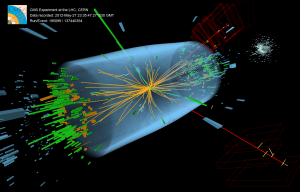 [image credit: the CMS collaboration]
[image credit: the CMS collaboration]
This event features a pair of highly-energetic photons (the two green lines in the middle of the figure) that originates from the decay of a Higgs boson produced during the proton-proton collision.
THE ROLE OF DIPHOTON EVENTS
Diphoton events (LHC collisions where a diphoton system or two photons are produced) are very clean: there is very little chance to reconstruct any other (non-photonic) particle as a photon. This contrasts, for instance, with jets of strongly interacting particles that can sometimes be mistaken as electrons.
In addition, in the Standard Model of particle physics, the rate of producing highly-energetic diphoton events is small and scales down with the photon energy.
As a consequence, observing many highly-energetic diphoton events can be identified as a hint for new phenomena or the existence of new particles.
DIPHOTON EVENTS AND THE HIGGS BOSON
LHC searches for highly-energetic diphoton systems have played a key role in the discovery of the Higgs boson in 2012 by the ATLAS and CMS collaborations. Both scientific publications are freely available by the way (please check the links).
The key property that has been studied in 2012 was the diphoton system invariant-mass distribution. The diphoton invariant-mass is calculated by combining the two photons as if they were arising from the decay of an unknown particle. The mass of this would-be particle can then be extracted from data and we can report its distribution.
The typical excepted behavior is given by the figure below:
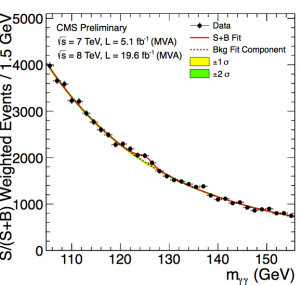 [image credit: the CMS collaboration]
[image credit: the CMS collaboration]
The x-axis is the diphoton invariant-mass, and the y-axis is the event rate. Around 125 GeV, we can notice a bump. This bump is the trace of the Higgs boson. The error bars are tiny, and there is only one chance in about 400 000 that this bump is not a Higgs boson.
Looking for bumps in the invariant-mass distribution of diphoton systems produced at the LHC is hence one option (amongst many others) for detecting the presence of a new particle at the LHC.
THE 2015 CHRISTMAS ANOMALY: THE 750 GEV DIPHOTON EXCESS
Last Christmas, both ATLAS and CMS publicly released results from the 2015 LHC run. Among all the available results, the diphoton ones have been very exciting. I show below the same figure as above, but with 2015 LHC data:
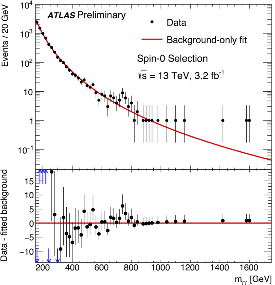 [image credit: the ATLAS collaboration)
[image credit: the ATLAS collaboration)
On this image, there is no Higgs boson (the x-axis starts at 200 GeV and the Higgs mass is of 125 GeV) but there is another bump at around 750 GeV. This would be the sign of a new particle with a mass equal to six times the mass of the Higgs boson.
The error bars on this figure are still large, and there is a good chance (1 over 20 roughly) that the bump is only a fluctuation in data.
The diphoton searches form hence an important channel for discovering new phenomena at the LHC.
The 750 GeV excess has triggered excitation and interests for most high-energy physicists, and more than 400-500 scientific articles on the topic have been written in six months.
MODELLING POTENTIAL DIPHOTON EXCESSES
In my article, my collaborators and I have first assumed the presence of a diphoton excess that would corresponds to a new particle of any mass (750 GeV or actually anything else for staying general). For clarity, we call the new particle decaying into a pair of photons an R boson that can be seen as a distant cousin of the Higgs boson.
As for the Higgs boson, the easiest mechanism to produce the R-particle at the LHC is the fusion of two gluons (that are constituents of the colliding protons). From existing data, the R particle must however couple indirectly (via another particle) to gluons (the springy lines below), via what we call a virtual loop of a new particle Q:
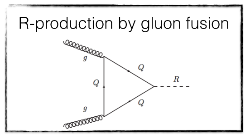 [image credit: mine]
[image credit: mine]
Our modelling therefore includes two new particles: an R particle (a sort of new heavy Higgs boson) and a Q particle (a new species of quarks). This is the simplest setup that could be built to explain any potential excess in the diphoton invariant-mass spectrum.
Since the R particle is electrically neutral, it cannot directly couple to photons. However, after accounting for the Q particles into a loop, the R particle can actually decay into photons (one replaces the gluons in the above picture by photons and read it from right to left).
PREDICTIONS OF THE MODEL FOR DIPHOTON PLUS JET EVENTS
The model above is very simple but can already be used for a variety of predictions. Two of them are highly connected to the production of a pair of photons:
Via the above mechanism, non-standard diphoton events can be produced at a large rate.
A pair of photon arising from the decay of the R particle can also be produced in association with a very energetic jet of strongly interacting particles (that will be called a jet).
The second item is a prediction of quantum chromodynamics. The production mechanism is illustrated by the following figure:
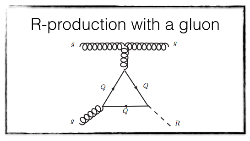 [image credit: mine]
[image credit: mine]
The final state gluon (the springy line on the right of the diagram) is a very energetic strongly interacting particle that will form a jet of composite objects made of quarks and gluons. This jet is what will be observed by LHC detectors (not the gluon itself).
My collaborators and I have calculated the rates to produce an R particle alone, and the rate to produce the R particle in association with a very energetic gluonic jet.
The ratio of these two rates is shown below, for three different R particle masses: 750 GeV (plain), 1500 GeV (dotted) and 2000 GeV (dot-dashed).
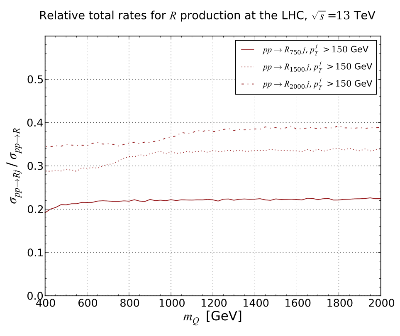 [Image credit: arXiv:1608.00084]
[Image credit: arXiv:1608.00084]
On this figure, the X-axis is the mass of the new Q particle which is found no to matter much. There is actually no way to get any information on the particle Q.
The results also tell us that if one observes an excess in diphoton events, one should additionally observe an excess in diphoton events where the two photons are produced together with a highly-energetic jet.
For instance, if the R mass is 1500 GeV and if one observes 20 events in excess to the Standard Model, one should then also observe 6-7 events where the R particle is produced with a jet. The ratio of rates is indeed of about 30% for any Q particle mass.
REVISITING THE 750 GEV EXCESS AND THE FUTURE
Going back to the 750 GeV excess of last Christmas, its properties do not satisfy the above requirements concerning the rates for events containing a photon pair and one extra jet. The observed rate is found not to agree with the quantum chromodynamics predictions.
Quantum chromodynamics is very unlikely to be wrong, as it is in agreement with an enormous amount of data (recorded during the last 50 years). So that either the mechanism postulated for an explanation of the excess is not the good one, or the excess itself is a statistical fluctuation and nature only wanted to have fun of us.
The property discussed above challenges the majority of the models that have been proposed for explaining the 750 GeV excess: many of those models do not agree with data in other channels. In the meantime (one month ago), the ATLAS and CMS diphoton results have been updated at the ICHEP conference and the bump has now disappeared. This explains the inconsistencies: there is no R boson.
SUMMARY
In the case where a diphoton excess would be observed in future LHC data, it is important to study extra search channels where the diphoton system is produced together with an extra jet. This can bring constraints on plausible explanations for the observations and help in unraveling the nature of the excess.
REFERENCES
- arXiv:1608.00084, Investigating the jet activity accompanying the production at the LHC of a massive scalar particle decaying into photons, accepted for publication in Physics Letters B (a SCOAP3 journal hence accessible for free).
